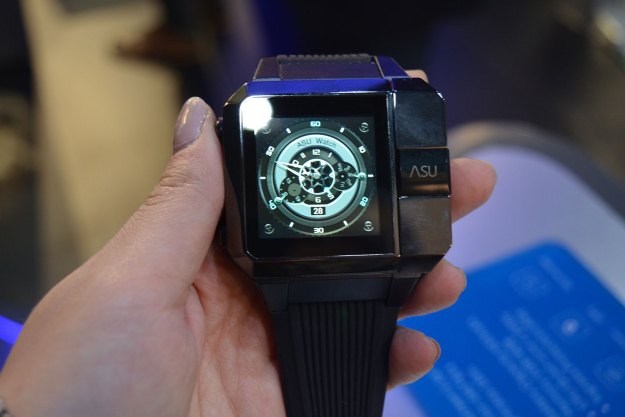
“It’s impressive the Asu Smartwatch has a built-in projector, but its use case remains uncertain.”
- Lightweight
- Durable
- Comfortable watch strap
- Built-in heart rate sensor
- Projector is glitchy
- Bulky design
- Usecase remain uncertain
Smartwatches are quite capable devices. We use them to track fitness activity, and keep us up-to-date on notifications by simply scrolling through a touchscreen display. If you’ve never asked, “what if I could project this data onto my hand,” don’t worry — Haier has, and it’s now possible with the Haier Asu smartwatch. It has a built-in projector, which is certainly something we’ve never seen before.
Wrist projector
At first glance, the Haier Asu looks like a calculator watch from the pre-internet age. With a sporty all-black case, a rubber watch strap, and a gargantuan size, the Asu feels durable enough for runs and outdoor activities. It’s 1.54-inch touch-screen is large and the screen gets plenty bright, but it’s cut off by a mini projector on the right edge.
The watch is built for men, but Haier hopes to launch a women’s version in the future with a much smaller watch face. As a woman, I’m pleasantly surprised with how light the Asu feels despite its bulky look. It is undoubtedly too big for my wrist, though, and looks comical. The rubber watch strap has enough notches so it doesn’t feel like the smartwatch is too loose.
The projector – which is easily the most intriguing part of the watch — is still a prototype, and we weren’t able to test it out. Essentially, it’s meant to turn your hand into an interactive display. By projecting onto your wrist, you can tap and swipe on your hand to control what you see on the watch’s screen.
The feeling quickly goes away when you realize the watch is meant for adults.
The Asu projects information from the watch clearly onto the wrist, but it’s tough to think of a time we’d ever need to actually use it. The idea is to show you more of the screen, which can be tricky for watches when your fingers end up being in the way. For example, you can use a virtual keypad on the watch screen to type in a phone number, which will be projected onto your wrist so you know it’s correct. Projecting this information could also be handy if a sweater ends up covering the watch, but we don’t think the Asu offers a proper solution for those problems.
We did have fun with the “Draw” app, which lets you to aimlessly doodle on the touch-screen while simultaneously projecting it on to your hand. But what’s the point? You may as well just draw on your smartphone.
Another confusing feature is the ability to project a dancing man to your hand. By tapping on a specific app, a tiny man appears on the display and starts dancing – which is then projected to your hand. Like the Asu watch, it’s unclear why anyone would need this bizarre feature. It’s hard not to admit that it was entertaining – even if only for a few seconds.
We couldn’t imagine working out with such a bulky smartwatch.
Being able to project information from the side of our watch to our hand made us feel like a Spy Kid, but the feeling quickly goes away when you realize the watch is meant for adults.
The Asu Smartwatch packs 1GB of RAM and 8GB of internal storage, along with a 1.2GHz quad-core processor. There’s a 650mAh battery, which is double the size of the average men’s smartwatch. It’s unclear how long the watch will last on a single charge, but it’s likely the projector that needs so much juice..
With an integrated heart-rate sensor, it’s clear Haier is angling the Asu for fitness buffs. We can’t imagine working out with such a bulky smartwatch, and the projector just feels like a useless gimmick.
Capable of tracking activity, receiving notifications
On the left side of the watch, there are two buttons – the top one brings you to your notifications which you can swipe through to also access a keypad for phone calls. The bottom button brings you to the home screen, with watch faces that can be customized by holding down on the display.
The Asu also has 4G LTE connectivity, so you’ll have to insert your own SIM card to be able to send and receive phone calls and text messages. Aside from the “Running” and “Fitness” apps that keep track of your activity, there’s also an app to store your music, a weather app, and WeChat is already installed.
We didn’t find any issues with performance as we scrolled through all of the different apps. Some apps took some time to load, but otherwise the interface feels smooth and easy to navigate.
Price and availability
Haier hasn’t mentioned a price tag for the Asu Smartwatch, but the device will launch first in China. The company plans to expand availability to other countries in the future.
Editors' Recommendations
- This is the OnePlus Watch 2, and it looks incredible
- TicWatch Pro 3 Ultra hands-on review: Amazing battery life
- Samsung Galaxy A53 5G hands-on review: Your long-term partner
- DJI Mavic 3 hands-on review: The long-awaited return of the king
- Skagen’s new hybrid smartwatch has an e-ink screen and mechanical hands









